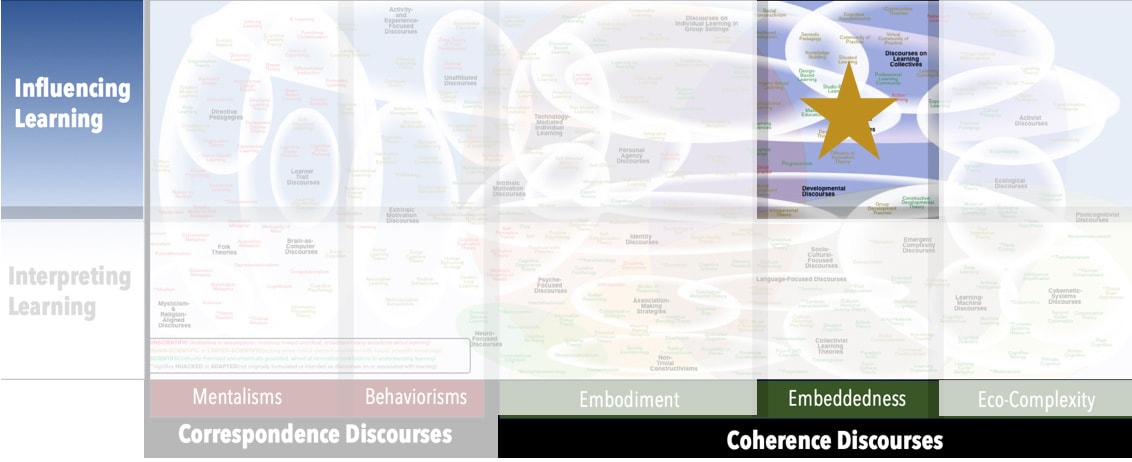AKA
Knowledge Building Community
Knowledge-Building Community Model
Focus
Creation and improvement of cognitive artefactsPrincipal Metaphors
- Knowledge is … cognitive artefacts
- Knowing is … using cognitive artefacts
- Learner is … a collaborator (individual with/in collective)
- Learning is … participating (in honing cognitive artefacts)
- Teaching is … guiding
Originated
1990sSynopsis
Knowledge Building focuses on the processes used by a community of individuals to create and hone cognitive artefacts. Engagement in such processes should support the development individuals’ knowledge on the topic. Knowledge Building addresses personal and interpersonal skills useful in such processes, offering practical advice on modes of questioning, qualities of dialogue, and attitudes toward evolving ideas. It also offers detailed information on senses of agency, responsibility, and relationship that should be nurtured among individuals. Associated discourses include:- Distribution of Responsibility for Knowledge Generation (David Clarke, 2000s) – a construct intended to afford agency to all participants in a Knowledge Building community, proposed as an alternative to the prominent “student-centred versus teacher-centred” dichotomy
- Knowledge Creation Metaphor (Saami Paavola & Kai Hakkarainen, 2000s) – Less a metaphor for learning and more mash-up of several popular Proxies for Learning, the Knowledge Creation Metaphor is a description of collaboration-based, object-mediated activities of generating new insights.
- Rapid Collaborative Knowledge Improvement (Rapid Learning Activities) Chee-Kit Looi, 2010s) – strategies to enable Knowledge Building that are specifically tailored to the time and space constraints of modern schooling
Commentary
While proponents contend that Knowledge Building addresses the needs of an innovation-driven, knowledge-age society, a close analysis of its metaphors and associated vocabulary reveals assumptions that are more typical of Correspondence Discourses than of Coherence Discourses. For example, its orienting metaphor of “knowledge as cognitive artefacts” bears uncomfortable resemblances to the Acquisition Metaphor’s “knowledge as object” and the Construction Metaphor’s “knowledge as assembled object.” Further, proponents of Knowledge Building often distinguish “learning” from “knowledge building” – and not because these notions tend to be applied to different levels of activity (i.e., individual and collective, respectively). Rather, learning is described as an internal and mostly unobservable process, whereas Knowledge Building is seen as external and mostly observable. Consequently, while most of the theory’s assumptions and assertions align with Embeddedness Discourses, it is rarely explicitly linked to other Embeddedness Discourses.Authors and/or Prominent Influences
Carl Bereiter; Marlene ScardamaliaStatus as a Theory of Learning
The authors of Knowledge Building explicitly assert that it is not a theory of learning, perhaps attributable to a failure to interrogate “learning” and a consequent reliance on assumptions that are more typical of Folk Theories than contemporary academic offerings.Status as a Theory of Teaching
Knowledge Building is a theory of teaching. Its advice and structures have been demonstrated to be highly supportive of the development of collective knowledge.Status as a Scientific Theory
Knowledge Building is associated with a well-developed research program and has a substantial evidence base in support of both the efficacy of its processes and their impact on students’ learning.Subdiscourses:
- Distribution of Responsibility for Knowledge Generation
- Knowledge Creation Metaphor
- Rapid Collaborative Knowledge Improvement (Rapid Learning Activities)
Map Location

Please cite this article as:
Davis, B., & Francis, K. (2023). “Knowledge Building” in Discourses on Learning in Education. https://learningdiscourses.com.
⇦ Back to Map
⇦ Back to List
